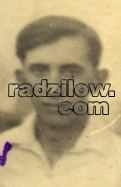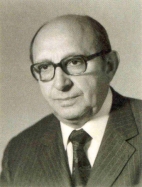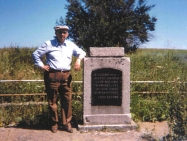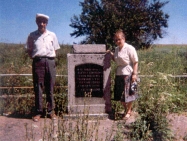|
Voyev. Historical Commission [The seal says Warsaw]
Bialystok
The Development of the Partisan Organization in the Bialystok Ghetto
Told by Berel Wasersztejn at age 30, born in Radzilowa, lived in the Bialystok ghetto
Recorded by E. Shtayman.
Bialystok, June 5, 1945
After the pogrom of Feb 5, 1943, that is after the first action in the Bialystok
ghetto, there occurred the first split in the resistance organization which had
already existed in Bialystok in small strictly secret groups from the month of
December 1941, and which had as their task the organization and training of the
youth in the battle against Nazism.
|
|
|
 |

|
|
Berel Wasersztejn,
1933 and 1970's |
|
| |
|
The aforementioned pogrom showed the majority of the youth how the existing
resistance organization is impractical and worthless, because every battle that
the Jews will take on in the ghetto will end with fiasco [disaster].
Therefore, they faced the critical necessity to come up with an effective
fight against the enemy, that is, organize partisan groups that will go into the
forests and plan their battle from there.
The first organizers of the new faction were Wasersztejn, Berel and Gershuni,
Shlomo.
Wasersztejn, while already a part of the resistance organization, had already
come to the decision to go to the forest, and had also planned it with the
secret support of two participants of the committee of the organization -- Yodita and Yuzhik. At that time three groups went out, a total of 15 men, that
were in the forest from the 10th of the 1st
[month, January] till the 25th of the 1st [month, January]
in the year 1943. Because of the hard winter
and their poor preparation for the conditions, they were forced to return to the
ghetto. Wasersztejn, however, remained convinced that the partisan way is the
only course for the Jewish battle-ready youth.
Shortly thereafter, there occurred the pogrom of February 5. Shlomo Gershuni was one of those who also came to the
conclusion about the necessity of a partisan-movement in the ghetto.
To the organization work was also drawn T.
Yodita who, as mentioned, gave financial and moral support to the first pioneers
in the forest. Also because of the activity behind the scenes of her
co-workers in the committee of the resistance organization, years of the work
was reduced.
In the month of March 1943, the first meetings of the faction were held. The
first meeting took place at 40 Jurowiecka in the house of T. Yodita. It was
decided to re-organize the groups of the new faction, and get right to the plan
to go out into the forest. And at the same time to conduct a
broad explanation
[exploration] effort in all the
circles [groups]. A linkage was developed with the Soviet representatives
in Bialystok.
|
|
|
|

|
|
Berel's return trip to Radzilow
in the 1980's, standing next
to the Memorial to the
Holocaust victims |
 |
|
One of the Bialystok partisans (later living
in France) and his wife, both of whom went with Berel on the trip |
|
|
| |
|
Right away a radio program was arranged which made it possible to get
oriented in the political and
practical situation,
and communications were developed for the groups. The
commander/leader of the news messages was Meyer Mutchnik, who knew several
languages and was especially outstanding in the precision and the feasibility of
the entrusted messages.
Also drawn into the organizational work were Myata Kubarevski and Fanya
Mitch, who were especially excellent at every realm of the work.
Through friend Kubarevski, a link was
forged as military instructor with friend Dr. Shimon Datner, the former teacher of M. Kubarevski. This Dr. Datner, about whom we will write later, played one of the
most important roles in the future development of the partisan organization in
Bialystok, actively working together in all fields with his wife,
Ruzheh, his 19-year-old daughter Mika, and the young 13- to 14-year-old little
daughter, Leela.
In the first few weeks of its existence, the organization managed to get some
arms, partially brought into the ghetto by their own comrades, partially
obtained from a private group that had also talked about going out to the forest
and who joined the newly founded organization. All in all, the organization at
that time had 12 guns and 2 revolvers.
To carry out all the transactions at the entrance and the gate, such as
bringing in arms, leading people out, and so on, the organization drew in to its
work the already known machers [big shots] under the pseudonyms "the giant and
the barefoot one." These two played a meaningful role in the life of the
organization.
The committee of the new organization decided that friend Wasersztejn
together with 8 comrades would be the first to go to the forest,
and there to prepare the
spot for the rest
of the comrades. They made all the necessary preparations. At the
beginning of April they left the ghetto. Because of poor orientation, instead of
arriving at their intended direction in the woods, they landed up near Suprasl
by Wasilkow. Here they were forced to stop because it was almost daylight. For a
whole day they remained on a German place under the indirect shelling from the
Germans who were practicing. The Germans were even a few times 30 miles from the
hiding group. But thanks to their good condition [position] they were not
discovered. On the second night, the whole group arrived in Suprasl.
In the course of 5-6 days, they located an appropriate neighborhood [section]
in the woods near Lupawi,
located water sources, which is one of the main problems in the woods, and
became acquainted with the area, and then sent out their liaison friend
Kurtzgar Baranzshitzka
[the original spells it both Kurtzgar and Kurtzgarn and they are left that way
accordingly throughout the text] back to the ghetto to bring the second group
into the forest. Friend
Kurtzgar, from
Radzilow, was known as an energetic and eager woman, and she had an Aryan
appearance which was so suitable for the assignment. But it turned out
differently. Four hours after leaving friend
Kurtzgar, about 9:00 am, the group was working on arranging the camp for
the new group and suddenly there was heard the sound of an oncoming wagon. The
wagon stopped and the voice of friend
Kurtzgar
called out Berel! (Wasersztejn). It immediately became clear to the group that
friend
Kurtzgarn was detained by the
Gestapo and she takes them to show the location of the group. Realizing their
situation, the comrades managed to run away [escape] even in the face of the
shouts "Stop!" and the shooting by the Germans. Two remained lying in the nearby bushes and saw for
themselves friend
Kurtzgarn and the
Germans who searched for the hiding place.
The group decided to turn back to the ghetto and to go out to the woods after
the people would be better organized, trained and armed. On the way back to
Bialystok, they were again shot at by the village Ogrodniczki,
but there were no victims.
After the return of the group to the ghetto, there began a strengthened work
in the organization and it took on the form of a true partisan movement. At the
head of the work stood the above-mentioned friend Dr. Datner - Syata. As
mentioned, Dr. Datner began his work in the organization as military instructor,
preparing the comrades for going out to the forest. Towards that end, lectures
took place at 7 Belamtatshabska [correct Polish spelling unknown] at which Dr.
Datner taught the comrades how to handle arms. Besides the military schooling,
Dr. Datner gave the comrades the comprehensive partisan training. In a short period of time, the private living quarter [apartment]
of Dr. Datner was converted into a partisan headquarters -- here took place the
meetings of the committee, from here the orders and decrees of the organization
went out, here was the arsenal of arms and equipment of the comrades. But not
only the apartment of friend Datner was entirely in service of the organization.
Not only friend Datner gave himself entirely to the movement. In carrying out
all the historically important responsibilities, his wife Rosa participated
actively, his daughters Mika and Leela -- his wife as a qualified nurse brought
many uses to the organization. About her dedication and willingness in this
work, there is as witness the case of a go-between, his nationality was Russian,
who was wounded on his way going on a mission from the forest to the city. As
soon as the wounded man arrived in the ghetto, friend Datner took him to her
home, gave him assistance, and helped him until he was fully recovered. Everyone
is aware how much danger this kind of attention had for the entire family.
Friend Datner behaved like a revolutionary and fulfilled her duty till the end.
(The go-between is still alive today, his name is Mishka Bunglazik). Also, both
daughters of Dr. Datner participated actively in the work. The little 13- to 14-year-old Leela even as a child understood the importance of her father's work. She
was outstanding in terms of her extraordinary talent and ability. All the
important meetings took place in her presence, she knew in detail everything
that was going on and what was planned, and nobody in the world could get a word
out of her -- sometimes she was more discreet than the adult comrades. The
little Leela frequently carried out the task of a contact person in the ghetto
with the greatest boldness, cold bloodedness and responsibility of an adult.
In the month of May 1943, it was decided that a group of 15 men would leave
the ghetto and go to the forest under the leadership of Dr. Datner. On the
evening of May 24th, around 10:00 o'clock, all those who were armed with rifles
and equipment left the house of Dr. Datner and went to the ghetto fence. In the front went a group of three persons
with the well-known leader, the "giant." Behind them was the entire group and in
front was friend Datner. The group went out through the fence on Jurowiecka
Street and in a little while when they were not so visible, the group went on.
When the group passed Smolnad Street, a vehicle with lights on suddenly drove
through, and the whole group had to throw themselves on the ground so they
shouldn't be noticed. When they got up, the group went on in the opposite
direction. Comrade Datner decided that it made no sense to go on and he went
back into the ghetto together with his people. Then he noticed that three
friends were missing -- they got lost in the dark. Friend Datner decided to go
out again by himself through the fence to look for them. During that time the
German watch had left but friend Datner had been noticed. Analyzing the
situation, friend Datner drew out his big Belgian pistol and shot at the Germans
a whole magazine of shots. Right away, you could hear calls "help, help"
-- one
person was badly wounded. (Later he died of the wounds). At the same time, the
three comrades who had remained on the other side of the fence also started
shooting. From all sides, Germans came running to help the patrol and friend Datner had to pull back. With one leap, friend Datner was on the other side of
the fence -- that means inside the ghetto -- and started on his way to his
home. Here waited for them the Secretary of the organization, Yodita, and all of
them together effaced all tracks [traces] of a search. For the sake of security, Dr.
Datner and friend Wasersztejn slept over at 19 Bialostoczanska Street at the
house of a friend from the organization, Myanek Broker. They stayed there till
the afternoon. On the second day there was a lot of unrest in the ghetto because
the Gestapo leader (well-known murderer) Freedel wanted to investigate what
happened but he got no results. The remaining friends from behind the fence
during the course of the day also came back into the ghetto, having buried their
arms outside the ghetto.
Some days later on June 3rd, the same 15 men went out in three groups of 5
each and arrived safely at the agreed-upon place in the Suprasl woods, where the
partisans of the Bialystoker ghetto originated.
In the ghetto, the organizational work continued beyond the partisans. Bombs
and mines were made in the ghetto environment or purchased from the Germans of
the 10th division of the Polish Military. At the end of June in the process of
making mines, three comrades died, among them Syama Kubarevski and Mashka
Goldberg and a red-headed student from the communications people between the
ghetto, city, and forest. New groups were organized, trained, and led out into
the forest. The work in the ghetto was led by friend
Kurtzgarn, Yudita, Kubarevsky, Fanye
Mitch, Meyer Mutchnik. In the course of three months, another three groups went
out to the forest, a total of 15 men.
Shortly before the liquidation of the ghetto, at the end of the month of June
1943, there occurred a joining together of the previous resistance organization,
the new faction of the partisans, and all the other Zionist and other
organizations. The coordination took place in the ghetto and in the forest.
In the course of this time, all the rest of the existing ghetto organizations
came to the conclusion about the necessity of going out into the woods as
partisans.
Unfortunately, no positive results of this coming together came about.
In the year '43, the 15th of July, there began the actual full liquidation of
the Bialystoker ghetto. A small portion of the remaining friends of the partisan
movement was not successful in escaping the ghetto. Some of them heroically fell
taking part in the self-protection uprising in the ghetto. With the liquidation
of the ghetto, the chapter of the organizational work of the partisan movement
in the ghetto came to an end.
Witness (signed name)____________
Recorder (signed name)___________
Chairman of the historical commission (signed name)___________
(SEAL)
(Jewish Historical Commission)
Warsaw |